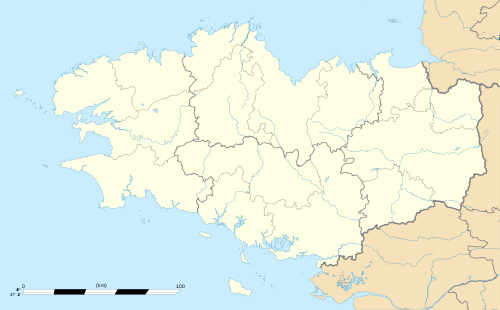Plouénan
| Plouénan Plouenan | |
|---|---|
| Commune | |
|
The town hall in Plouénan | |
 Plouénan Location within Brittany region  Plouénan | |
| Coordinates: 48°37′44″N 3°59′17″W / 48.6289°N 3.9881°WCoordinates: 48°37′44″N 3°59′17″W / 48.6289°N 3.9881°W | |
| Country | France |
| Region | Brittany |
| Department | Finistère |
| Arrondissement | Morlaix |
| Canton | Saint-Pol-de-Léon |
| Intercommunality | Pays Léonard |
| Government | |
| • Mayor (2014–2020) | Aline Chevaucher |
| Area1 | 30.64 km2 (11.83 sq mi) |
| Population (2008)2 | 2,422 |
| • Density | 79/km2 (200/sq mi) |
| Time zone | UTC+1 (CET) |
| • Summer (DST) | UTC+2 (CEST) |
| INSEE/Postal code | 29184 /29420 |
| Elevation | 0–88 m (0–289 ft) |
|
1 French Land Register data, which excludes lakes, ponds, glaciers > 1 km2 (0.386 sq mi or 247 acres) and river estuaries. 2 Population without double counting: residents of multiple communes (e.g., students and military personnel) only counted once. | |
Plouénan (Breton: Plouenan) is both a commune in the Finistère department of Brittany in north-western France and also a town within the commune.
The commune includes the town of Plouénan and the hamlets of Kerlaudy, Pont-Éon et Lopreden. It forms part of the Pays de Léon area.
Toponymy
The name of the area has appeared in a number of forms including Plebs Lapidea in 884, Plebs Menoen around 1150, Ploebenon in 1277, Plouenouven in 1279, Plebenoen in 1306, Ploe Benoan around 1330, Plebevenan in 1405, Ploebenan in 1467, Ploemenan in 1453 and Ploemenan in 1481.[1]
Plouénan comes from the Breton language word "ploe" meaning parish et Menoen, who was a Breton saint.[2]
Education
The town of Plouénan has two primary schools - one public and one private.
L’école Simone Veil[3] is the public school. The school was founded in 1816 and was, at the time, only open to boys. The school moved to its current site in 1906. In 2017, the school, then known simply as L'école Publique du Bourg, was renamed in honour of Simone Veil - the renaming ceremony took place on 24 June 2017.[4] In 2017/2018, the school welcomed 109 children. The school was in the first wave of schools to return to a four-day week pattern (with the school remaining closed on Wednesdays).[5]
In 1946, a parents' association[6] (L'Amicale Laïque[7]) was formed to raise funds for the school and children. At various points during the year, it holds events including the annual kermesse.
L’école Notre Dame de Kérellon[8] is a private school aligned to the Catholic church. In 2015/2016, the school had 131 children.
Population
Inhabitants of Plouénan are called in French Plouénanais. The official population figures are provided by the French statistical body INSEE.[9]
| Historical population | ||
|---|---|---|
| Year | Pop. | ±% |
| 1962 | 2,642 | — |
| 1999 | 2,381 | −9.9% |
| 2008 | 2,422 | +1.7% |
The next census is being held in early 2018.
See also
References
- ↑ "ETYMOLOGIE et HISTOIRE de PLOUENAN". Info Bretagne. Info Bretagne. Retrieved 6 February 2018.
- ↑ "ETYMOLOGIE et HISTOIRE de PLOUENAN". Info Bretagne. Info Bretagne. Retrieved 6 February 2018.
- ↑ "L'école Simone Veil". Plouenan.fr. Retrieved 6 February 2018.
- ↑ "École publique. Simone Veil à l'honneur". Le Télégramme. Le Télégramme. Retrieved 6 February 2018.
- ↑ ""Cette année, on ne faisait plus qu'une garderie améliorée"". Libération. Libération. Retrieved 6 February 2018.
- ↑ "L'Amicale Laique". Plouenan.fr. Retrieved 6 February 2018.
- ↑ "L'Amicale Laique". Facebook. Retrieved 6 February 2018.
- ↑ "L'école Notre Dame de Kérellon". Plouenan.fr. Retrieved 6 February 2018.
- ↑ "INSEE". INSEE. Retrieved 6 February 2018.
- Mayors of Finistère Association (in French)
External links
| Wikimedia Commons has media related to Plouénan. |
- French Ministry of Culture list for Plouénan (in French)